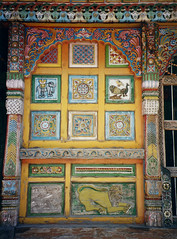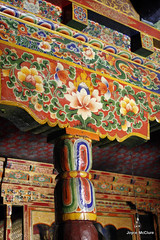
Elder Futark Runic Script Symbols, from Olaus Magnus 1555. Read the following website: Mystery of the Futhark Alphabet.
According to the following linked article by Juan-José Marcos (2008) the Gothic script style as seen with small fonts in the illustration over has nothing to do with the ethnicity of the Goths, but was most likely introduced by the Christian Crusaders in Europe during the Medieval period. Likely it is the same with the Gothic language in general. The period of the Gothic script started about the 13th century and lasted to the 16th century, however in the German areas and German influenced areas Gothic scripts were still used in the 18th century. The Nordic Goths had settled the Nordic before the Common Era according to some old texts and archaeological findings. The ancient Nordic Goths used runic scripts. It is documented that the runic script after the Medieval and still in the 1800eds were preserved by the Laplander = Sami people in runic drums and calendars (an example). Read more in the blog post from 13/04/09: Asian cultures, people and old texts on the Asian origin of the Ancient Nordic Goths. There are pictured other examples of Runic scripts from the Nordic areas in other postings of this blog.
 The futhark on the Vadstena brakteat, Sweden. Dated to the 6th Century. It is written from right to left.
The futhark on the Vadstena brakteat, Sweden. Dated to the 6th Century. It is written from right to left. Kylver runestone from Stånga in Gotland, Sweden. Dated to about 400 CE. Some of the runes from this and other early runic scripts in the Nordic were later turned.
Kylver runestone from Stånga in Gotland, Sweden. Dated to about 400 CE. Some of the runes from this and other early runic scripts in the Nordic were later turned. The futhark on the Vadstena brakteat, Sweden. Dated to the 6th Century.
The futhark on the Vadstena brakteat, Sweden. Dated to the 6th Century.Compare to the following script is from Gandhara, Kharosthi, found in Hashtnagar (earlier name is Ashnagar) and dated to 384 of an unknown era.
 The Gandharan or Kharostihi script is used at least since the time of Ashoka, some of his edicts from the northwestern areas of present India and Pakistan was written in Kharosthi. Like the first Nordic Runes the earliest Kharosthi scripts were commonly written from right to left, but some inscriptions were from early on written from left to right. Compare the symbols at the side panel of the Hashtnagar (Ashnagar) Gandharan pedestal with the 13th - 15th runic symbols on the Kylver runestone from Iron Age Sweden.
The Gandharan or Kharostihi script is used at least since the time of Ashoka, some of his edicts from the northwestern areas of present India and Pakistan was written in Kharosthi. Like the first Nordic Runes the earliest Kharosthi scripts were commonly written from right to left, but some inscriptions were from early on written from left to right. Compare the symbols at the side panel of the Hashtnagar (Ashnagar) Gandharan pedestal with the 13th - 15th runic symbols on the Kylver runestone from Iron Age Sweden.
 Kylver stone from Stånga in Gotland, Sweden. Dated to about 400 CE. Source: Sigurd Agrell, "Lapptrummor och runmagi" (1934). Some of the runes from this and other very early runic scripts in the Nordic were in later runic scripts turned. Kylver Stone
Kylver stone from Stånga in Gotland, Sweden. Dated to about 400 CE. Source: Sigurd Agrell, "Lapptrummor och runmagi" (1934). Some of the runes from this and other very early runic scripts in the Nordic were in later runic scripts turned. Kylver Stone An early Runestone: Möjbrostenen from Hagby (first placed near Möjebro), Uppland, Sweden. As other early runic scripts (e.g. Kylver stone) from about 300 - 400 CE this is written from right to left, and from bottom right and up. Later Runestones were written from left to right. The text is “Frawaradar anahaha is laginar”. Source: Oscar Montelius (page 81, 1905) Later runes were read from left to right and some of the runic symbols were turned. Study this stone here: Visa bild Sök i samlingarna Historiska museet
An early Runestone: Möjbrostenen from Hagby (first placed near Möjebro), Uppland, Sweden. As other early runic scripts (e.g. Kylver stone) from about 300 - 400 CE this is written from right to left, and from bottom right and up. Later Runestones were written from left to right. The text is “Frawaradar anahaha is laginar”. Source: Oscar Montelius (page 81, 1905) Later runes were read from left to right and some of the runic symbols were turned. Study this stone here: Visa bild Sök i samlingarna Historiska museetRunic alphabet
 Ring with Runes found in Norway from the Bronstedt collection. Picture from Project Runeberg.
Ring with Runes found in Norway from the Bronstedt collection. Picture from Project Runeberg.Sveriges runinskrifter by Erik Brate (1922)
 Bronze Age axe with a carved runic symbol found at Gotland Sweden. It is assumed by C.E. Lindberg (1873) that the runic symbol is of newer date than the axe. However this is an assumption.
Bronze Age axe with a carved runic symbol found at Gotland Sweden. It is assumed by C.E. Lindberg (1873) that the runic symbol is of newer date than the axe. However this is an assumption.Elder Futhark, from c. 2nd to 8th Century CE This is the earliest runes in the Nordic. Definitively used by the ancient Nordic Goths.
Runestones
Norske runeinnskrifter fra pre-vikingtid
Younger Futhark used from 800 CE. This change might be a natural development within the runic script, it later developed to what is called "Medieval runes".
Nordic:
 Codex runicus, a vellum manuscript from c. 1300 containing one of the oldest and best preserved texts of the Scanian law (Skånske lov), written entirely in runes.
Codex runicus, a vellum manuscript from c. 1300 containing one of the oldest and best preserved texts of the Scanian law (Skånske lov), written entirely in runes. Sami Runic Calendar studied by Eirikr Magnusson published 1877. Magnusson suggests a date between 1230 – 1391 CE for the prototype of this particular calendar. The runic script developed over time and the runes on this calendar is "Medieval Runes". Read more about this calendar in Saamiblog.
Sami Runic Calendar studied by Eirikr Magnusson published 1877. Magnusson suggests a date between 1230 – 1391 CE for the prototype of this particular calendar. The runic script developed over time and the runes on this calendar is "Medieval Runes". Read more about this calendar in Saamiblog.There are Nordic Runes that are still not decoded:
Prosjektet for Samnordisk runtextdatabas: "Runfynd 1987" by Thorgunn Snaedal, Marie Stoklund and Marit Ählén (2004).
Photos of Swedish Runic stones or Runsten.
To put old scripts in a larger perspective:
Bànpō dated to 4th millenium BCE
Oracle bone script Dating varies between 14th -11th centuries BCE to 1200 - 1050 BCE.
Bramhi scripts
Kharosthi, Kharoshthi or Gāndhārī script About 3rd Century BCE. Kharosthi script was used in some of the Western Indian Ashoka edicts (272 to 231 BCE).
Taxila Copper Plate, Moga inscription, Kharosthi script dated to a period between the 1st century BCE and the 1st century CE.
Kharoshti Script.
Kushan Birch Bark Script.
A Gandhari version of the Rhinoceros Sutra, Kushan era, 1st century CE.
Issyk script
The Issyk script is an old runic inscription dating back to 5th century BCE found in Issyk in present Kirgizistan, near the borders of Kazakhstan and China. This is an indication of the origin of the runic scripts in Asia, to areas that is close to the middle kingdoms of India.
Issyk script dated to 5th - 4th century BCE
Carbon dating of Issyk kurgan
А. Аmanjolov (2003) Proto-Türkic rune-like inscription on silver cup R. Ili Runic and Greko-Graphical inscriptions.
 Orkhon script from the 8th century.
Orkhon script from the 8th century.Old Turkic Script:
“Mainstream opinion derives the Orkhon script from variants of the Aramaic alphabet, in particular via the Pahlavi and Sogdian alphabets, as suggested by V.Thomsen, or possibly via Karosthi (cf., Issyk inscription).”
Several Gothic inscriptions are found in present Romania.
Theories of the existence of separate Gothic runes have been advanced, even identifying them as the original alphabet from which the Futhark were derived, but these have little support in actual findings (mainly the spearhead of Kovel, with its right-to-left inscription, its T-shaped tiwaz and its rectangular dagaz).
Nevertheless, it has proven difficult to find unambiguous traces of runic "oracles": Although Norse literature is full of references to runes, it nowhere contains specific instructions on divination. There are at least three sources on divination with rather vague descriptions that may or may not refer to runes: Tacitus's 1st century Germania, Snorri Sturluson's 13th century Ynglinga saga and Rimbert's 9th century Vita Ansgari.
 Photo: Pompeii Temple of Apollo Oscan inscription. Photo by Wknight84, 2008 Wikimedia.
Photo: Pompeii Temple of Apollo Oscan inscription. Photo by Wknight84, 2008 Wikimedia.Oscan script and language of the Roman Samnites (Greek - Roman)
Varang Kshiti alphabet (Orissa)
 Hindu wooden temple Chergaon Chamba, in Himalaya, Himachal Pradesh, India
Hindu wooden temple Chergaon Chamba, in Himalaya, Himachal Pradesh, India


















 Relief from Bharhut, Madhya Pradesh, India. Likely Mauryan. These dates back to about 150 BCE.
Relief from Bharhut, Madhya Pradesh, India. Likely Mauryan. These dates back to about 150 BCE.













